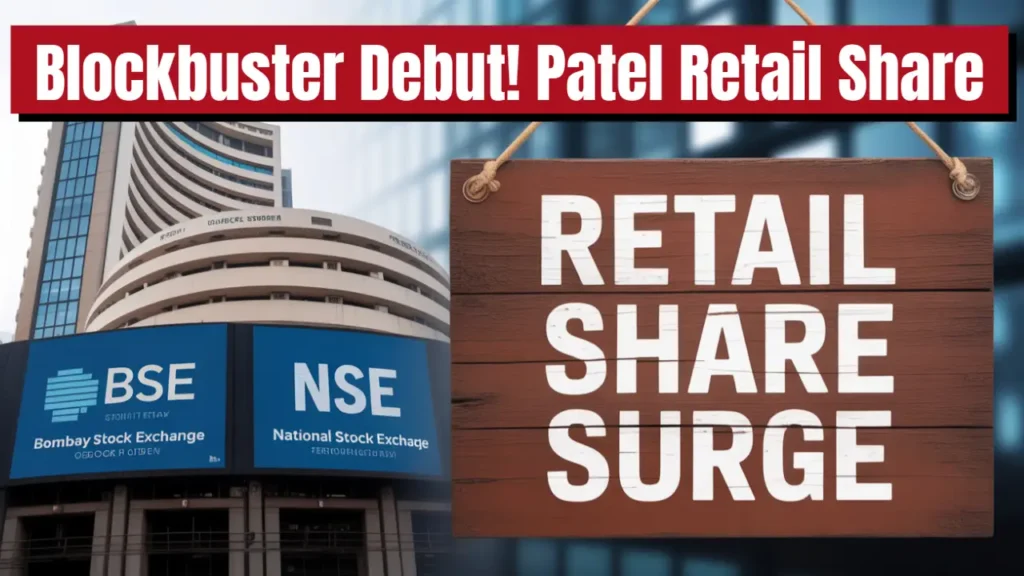Patel Retail, a value-focused supermarket chain, entered the Indian stock market with a strong performance today.
The company’s shares were listed at a significant premium to the issue price, reflecting the high level of investor confidence and excitement surrounding its Initial Public Offering (IPO). The successful debut is being seen as a clear signal of positive sentiment in India’s growing retail sector.

Patel Retail IPO Performance and Listing Details
The much-anticipated IPO of Patel Retail turned out to be a blockbuster. The shares were listed at ₹300 on the National Stock Exchange (NSE), giving investors an immediate 17.65% premium compared to the issue price of ₹255. On the Bombay Stock Exchange (BSE), the debut was even stronger, with shares opening at ₹305, a premium of 19.61%.
The IPO had opened for subscription between August 19 and August 21, and it received an overwhelming response from all categories of investors. In total, the issue was oversubscribed nearly 96 times. Qualified Institutional Buyers (QIBs) showed the maximum interest, subscribing over 272 times their allotted quota. Non-Institutional Investors (NIIs) also displayed strong enthusiasm with a 108 times subscription, while retail investors subscribed 42 times, showing that demand was robust across the board.
Market watchers had already predicted a strong debut based on the grey market premium (GMP), which was hovering between ₹45 and ₹50 ahead of the listing. The GMP suggested a listing price close to ₹300, and the actual market debut turned out to be in line with those expectations. This further confirmed the optimism among investors.
Company Profile and Expansion Plans
Patel Retail was established in 2008 with a focus on providing affordable shopping options to families in tier-III cities and suburban areas of Maharashtra. Operating under the brand name “Patel’s R Mart,” the company has built its reputation by offering a wide variety of products, including food, fast-moving consumer goods (FMCG), apparel, household items, and general merchandise.
As of May 2025, the company operates 43 stores and sells more than 10,000 different products. Its strategy of targeting smaller towns has helped it capture a loyal customer base in areas often ignored by larger retail chains.
The company raised ₹243 crore through its IPO. Out of this, ₹217 crore came from fresh issue of shares, while ₹26 crore was through an Offer for Sale (OFS) by promoters. According to the management, the funds will be utilized for several key purposes: ₹59 crore will go towards repaying debt, ₹109 crore will be used for working capital requirements, and the rest will be directed toward general corporate needs. This allocation is expected to reduce financial pressure and provide the company with more flexibility for expansion in the future.
Financial Performance and Business Strength
Patel Retail has shown consistent growth over the past few years. For the financial year ending March 2025, the company reported revenues of ₹826 crore. Profit after tax stood at ₹25.28 crore, marking a 12% growth compared to the previous year. The company has also demonstrated better operational efficiency, with EBITDA margins improving to 7%.
The financial strength of Patel Retail lies in its ability to manage costs effectively while expanding its presence. By focusing on smaller cities, the company has been able to avoid direct competition with larger supermarket chains that dominate big metros. This strategy not only ensures steady growth but also allows Patel Retail to build a strong foundation in emerging markets.
In addition to retail operations, the company has interests in manufacturing and exports, which adds to its revenue streams and provides long-term stability.
Future Outlook and Investor Sentiment
The strong listing of Patel Retail reflects investors’ confidence in the company’s business model and future growth prospects. Analysts believe that the organized retail sector in India is poised for rapid expansion, particularly in smaller towns where demand for modern supermarkets is increasing. Patel Retail is well-positioned to tap into this opportunity, given its early presence in these areas.
Going forward, the company is expected to focus on expanding its store network, enhancing supply chain efficiency, and increasing its private-label offerings, which generally yield higher margins. Its strategy of balancing growth with financial prudence is likely to attract long-term investors.
However, like any retail business, Patel Retail may face challenges such as rising competition, inflationary pressures on consumer spending, and supply chain disruptions. Still, the robust IPO response and premium listing show that the market has confidence in its ability to overcome these hurdles.
With a strong debut, Patel Retail has taken its first big step as a publicly traded company. Investors will now keep a close watch on its quarterly performance, expansion strategies, and ability to sustain profitability in the highly competitive retail industry.
F.A.Q.
– What was the Patel Retail IPO issue price?
The issue price for Patel Retail IPO was fixed at ₹255 per share.
– At what price did Patel Retail shares list on NSE and BSE?
On the NSE, shares listed at ₹300, while on the BSE, they opened at ₹305, giving investors a premium of nearly 18–20%.
– How much was Patel Retail IPO oversubscribed?
The IPO was oversubscribed about 96 times in total, with QIBs leading the demand at over 272 times.
– How much money did Patel Retail raise through the IPO?
Patel Retail raised ₹243 crore, including ₹217 crore from fresh issue of shares and ₹26 crore from an offer for sale (OFS).
– What will Patel Retail use the IPO funds for?
The funds will be used for debt repayment, working capital needs, and general corporate purposes to support expansion.
Also read:-